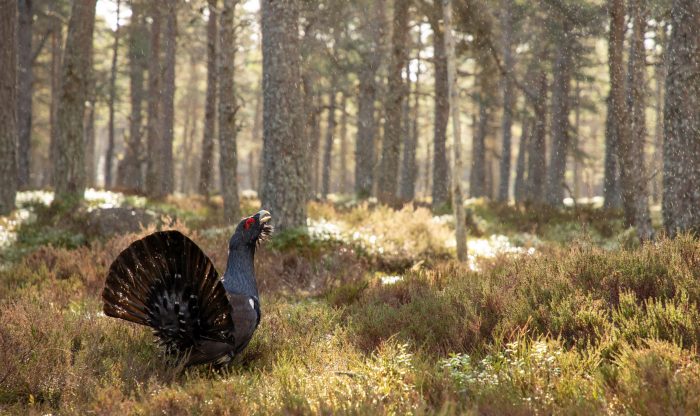National Lottery funding offers lifeline to threatened capercaillie
16th June 2020

The National Lottery Heritage Fund has today announced a £2 million funding package to create community-led projects to help save one of the UK’s rarest and most fascinating birds – the capercaillie.
Capercaillie are the largest grouse species in the world and have been living in our pine forests since the last Ice Age. In the UK, capercaillie are only found in Scotland with the Cairngorms National Park – and particularly Strathspey – being the last stronghold for this iconic species. Once in abundance, capercaillie numbers are now dangerously low, with fewer than 1000 birds thought to be left.
One of the core aims of the Cairngorms Capercaillie Project is about putting people at the heart of capercaillie conservation with funding available to help communities in the National Park to deliver their own community-led conservation action plans. The village of Carrbridge and the surrounding area has been acting as a pilot community during the development phase of the project, with their own capercaillie conservation action plan out for consultation with villagers right now. (https://www.cairngormscapercaillie.scot/carrbridge/).
In addition to that, there will be a considerable amount of work carried out to improve habitats for the birds alongside research into the genetic diversity of the current capercaillie population, strengthening current monitoring and raising general awareness of the plight of capercaillie.
Caroline Clark, Director Scotland of The National Lottery Heritage Fund, said: “So many people enjoy the wonderful nature of the Cairngorms National Park – and the importance of connecting with nature and our environment has become even more clear as we live through lockdown. This support from National Lottery players will give Cairngorms National Park residents and visitors an opportunity to help protect this precious landscape and the charismatic capercaillie, whether they are local businesses, residents or outdoor enthusiasts. This new community-led model has the potential to provide a sustainable way of caring for our natural heritage.”
This £2 million from the National Lottery Heritage Fund will help to unlock further local funding including forestry grants and contributions from private estates, helping to re-boot the local economy, securing a total budget for the Cairngorms Capercaillie Project of £2.9m
Xander McDade, Chair of the Cairngorms National Park Authority (CNPA) board welcomed the news: “We are delighted to hear that funding has been awarded from the National Lottery Heritage Fund for capercaillie conservation. We are determined to save the capercaillie for future generations and the added bonus is, we know the work carried out across the Park during the life of this project, will also benefit a whole variety of species that rely on healthy native pinewoods – including people!
“No-one could have known that when the Park Authority with its partners embarked on this initiative that we would be facing these difficult economic circumstances due to a global pandemic so this inward investment of £2 million at this time is set to be a welcome economic boost with new jobs and work for local contractors.
“Capercaillie numbers have been declining for several decades and previous conservation activities have certainly prevented us from losing them completely, but with numbers considered to be at an all-time low, it is extremely important that we take action across a variety of strands of work and this can only be delivered with funding support from the National Lottery Heritage Fund.”
The types of activities that the project is set to deliver include increasing and improving habitat for capercaillie, from planting new trees to the thinning of older plantations. Habitat work also involves controlling deer numbers to allow for natural regeneration of woodland areas, work that will be carried out by professional gamekeepers alongside predator management.
Two community rangers will be working with communities to help them put their capercaillie conservation plans into action and to enable more people to get involved in a range of environmental volunteering activities as well as capercaillie themed events. Along with genetic research, scientists and fieldworkers will be studying the breeding success of capercaillie and the impacts of predators on the birds.
Issie Inglis, a member of the Carrbridge Capercaillie Group said: “I am very proud that our village will be the first in this Park-wide initiative to produce its own capercaillie conservation strategy – a first for the UK – and which is out for consultation now. Our community vision is to make sure that capercaille will be in Scotland for everyone, forever, and to play our small part in global wildlife survival. To think that funding from the National Lottery Heritage Fund could potentially achieve that, and help boost their numbers, not just here but across the National Park, is very exciting.”
The project is being led by the CNPA, and is directly creating nine local jobs with various staff required to run the project. There is partner involvement across the National Park from a variety of organisations and businesses including: Balmoral Estate, Brook Forestry, Cairngorms Business Partnership, Carrbridge Capercaillie Group, Developing Mountain Biking in Scotland, Forestry and Land Scotland, Groves Forestry, Rothiemurchus Estate, RSPB, Scottish Forestry, Scottish Natural Heritage and Seafield & Strathspey Estates.
Capercaillie are known in Gaelic as the Horse of the Woods because of the distinctive noise they make. Capable of reaching about six years old, male capercaillie can hold territories of up to 50ha. Each spring they attend lek sites in the forest to perform a display of pops, whistles and flutter jumps to attract the attention of females. Drawn to leks used by capercaillie for generations, females may spend up to a week visiting the lek before mating. For the males this requires a significant investment of energy. In undisturbed forests they’re known to perform to awaiting females each day from first light until almost lunchtime.
You can find out more information about the Cairngorms Capercaillie Project at this website